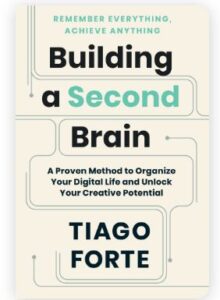
Thilini Gnanasena
When I opened the pages of Building a Second Brain by Tiago Forte, I thought I would be reading yet another guide on productivity. But this is not just about the speed of work or the volume of tasks completed; it is about a fundamental change in the approach to the processing of data in this digital age. Forte brings us a system to manage knowledge, creativity, and focus on a way that is much more natural and sustainable.

Information in digital form flows through the world in much more volume than just articles and podcasts. There are also YouTube videos, online classes, and even daily lectures. Although the fascination of the digital world’s streams of information is great, the opposite is also true, and the streams are overwhelming. Like many people, I too once thought the solution to some of my struggles was to highlight important sentences in the books I read or save hundreds of links to articles, only to unfortunately ignore and abandon the majority of those ideas’ months later. Forte’s proposal of a building block called a ‘second brain’ resonated strongly with me. Why rely on memories when a great alternative would be a streamlined and structured note-taking system that acts like an external brain, freeing up the primary brain for creation and problem-solving?
Most notably, building a Second Brain will be remembered for the CODE system: capture, organize, distill, and express, which Forte has so aptly formed. This system is at the heart of the method and makes building a second brain and the system surrounding it practical and approachable.
Capture: How many times have you had an interesting discussion or sustained, interesting thought, only to have it completely vanish later on? I now have a habit of writing quotes and insights, as well as any ideas, as soon as they occur. It can be as easy as sending myself an email or using an online note-taking platform.
Organize: Forte outlines the PARA method; Projects, Areas, Resources, Archives. Rather than having an illogical plethora of boundless folders, I now categorize my notes as active projects, assigned tasks, pertinent information, and archival storage. This framework keeps my notes dynamic and purposeful.
Distill: This is where the magic happens. Rather than saving unorganized articles or disorganized notes, I capture the key ideas. What is the one key insight? This makes the second brain system easier to review and more functional.
Express: Knowledge unshared is wasted. I have started transforming my notes into blog articles, strategies for my clients, and personal notes. It is about using the information as a pillar for influence.
This has completely changed the way I think about productivity and personal knowledge management.
Practical Benefits I Experienced
This book and its principles changed more than the way I work; it changed the way I live. Here are a few examples.
1. Reduced Overwhelm and Better Mental Clarity
Previously, I struggled to organize my thoughts; my mind was filled with so many. But with a trusted second brain system, I no longer feel the burden of having to remember everything. I feel lighter, more present, and clearer.
2. Effortless Content Creation
As a writer, I came across the blank page phenomenon. Now, my second brain is filled with quotes, insights, and ideas I can use. Writing is no longer about starting from scratch; it is about reshaping motivation.
3. Quicker and Better Decisions
Relatively, research is done faster. I go to my notes. My organized notes save me from spending hours on goals and marketing campaigns and help me make better decisions.
4. Reflecting on Personal Growth
When I analyze my notes, I can see the way I used to think. This makes me more aware of the progress I have made in my life. It is a capsule of my ideas and thoughts over the years.
5. Get Rid of Digital Guilt
Disremembered articles and neglected e-books used to be sources of concern for me. Not anymore. I now capture and store them in dwellings that are more suitable and access them at the right time. This construct has alleviated so much guilt from my digitized life.
The Importance of Building a Second Brain
This book is not only about productivity hacks but also about creating a system that provides tranquility. Forte does not require you to adhere to a rigid set of rules. Rather, he provides you with adaptable, guiding principles that you can customize to your preferred system, Notion, Evernote, OneNote, or even a bunch of folders.
The essence of Building a Second Brain is its convergence of knowledge management with life. It is not about engineering a productivity robot but, rather, about releasing the imagination and establishing a dependable collaborator for the brain.
For me, this book signified a paradigm shift. It enabled me to contain and utilize the information that I encounter daily. Rather than letting ideas escape, I now have a mechanism that changes them into something that is beneficial.
Creating a Second Brain is a book worth your time if you’re a writer, student, or even an entrepreneur or professional who has too much on your plate. It shows you how to build a support structure that helps to ease overwhelm, enhance creativity, and amplify the rate of learning over time.
His ideas are applied to much more than the scope of this review to reconfigure portions of my work and life so this, in essence, is not merely a book review on the work of Tiago Forte.
The last question I’d like to pose to you is: Suppose you were to start capturing and organizing your ideas for your second brain, what would be the first idea you would capture?